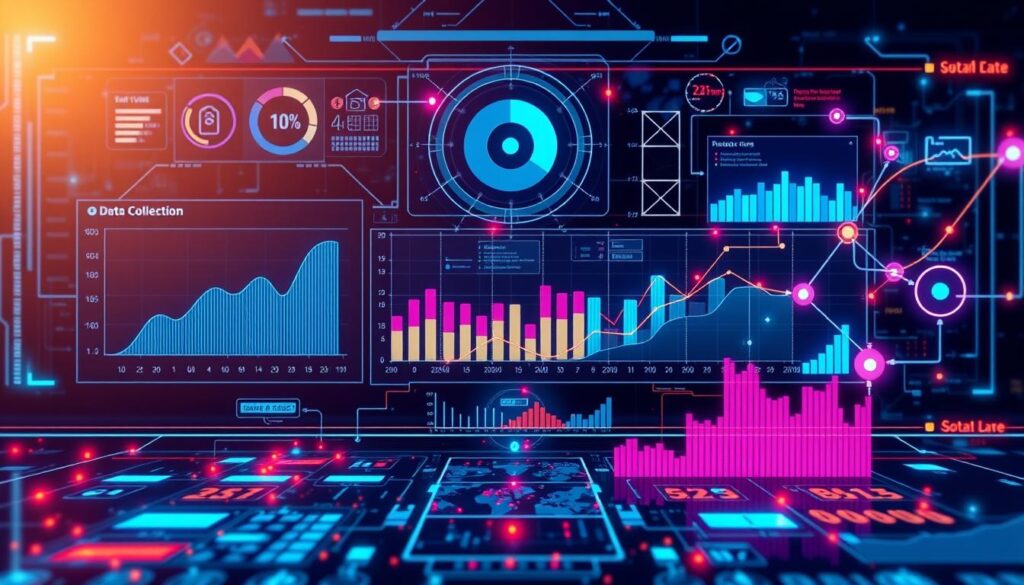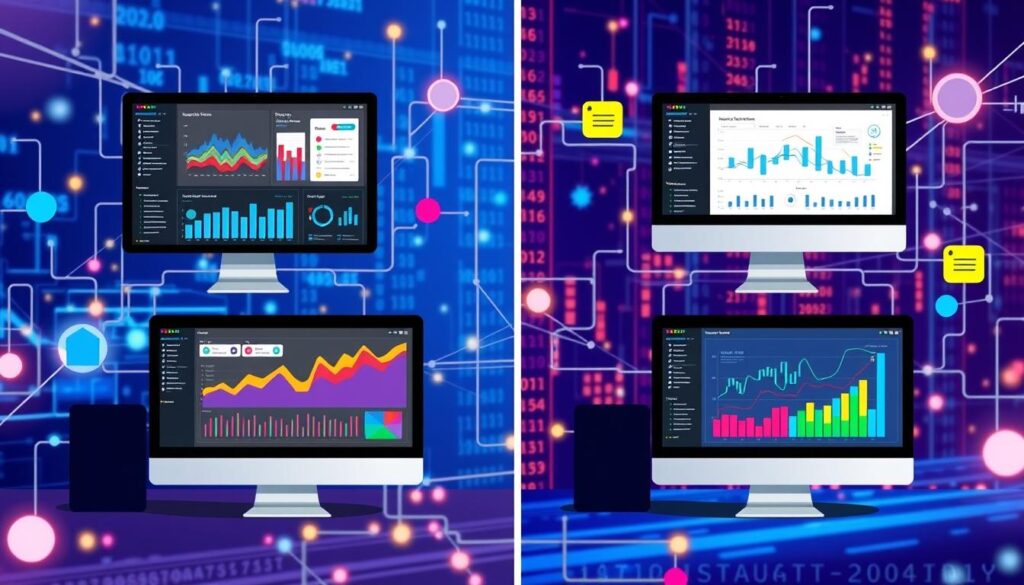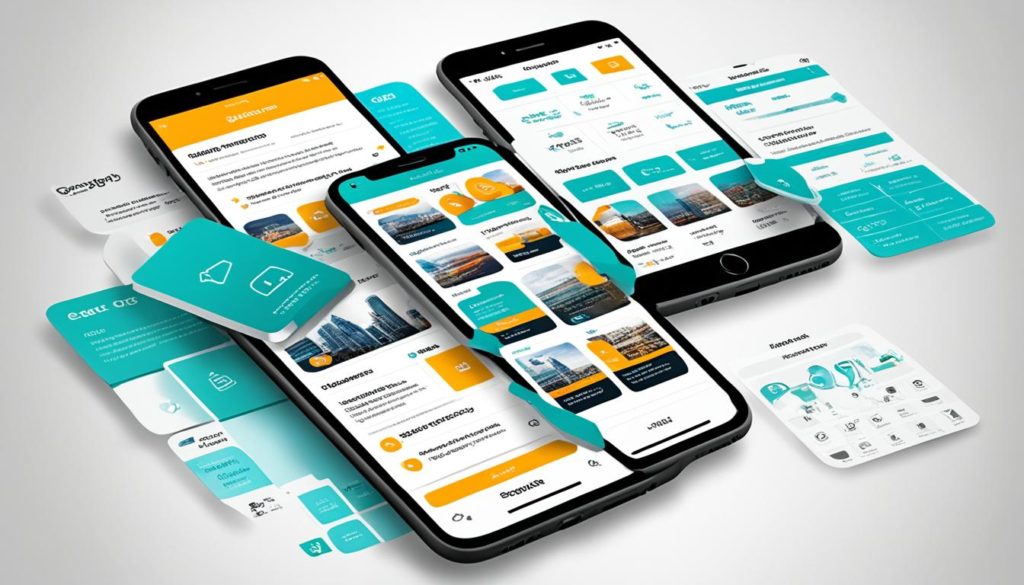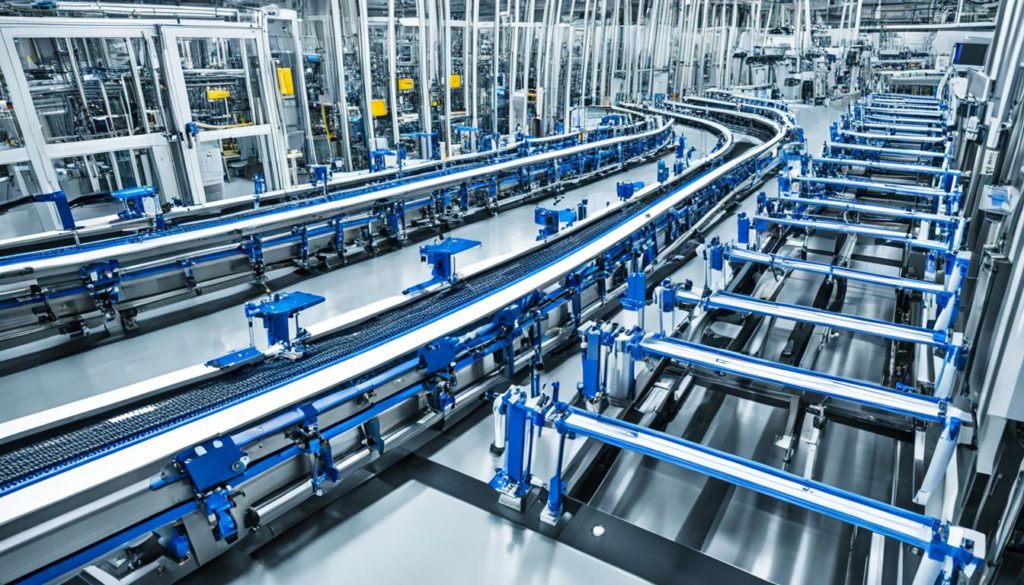Did you know that teams can cut data collection time by up to 50% with modern tools? The shift from old spreadsheets to advanced software like Fulcrum, starting at $15/month, has changed field research. Today, strong data collection software is key. It helps gather data and ensures accuracy, even without internet.
Below, we explore the best data collection software to boost your research.
Key Takeaways
- Fulcrum offers a starter plan at $15/month with 10 GB storage and integrates with Zapier for enhanced data management.
- FastField, priced at $25/user/month, is celebrated for its user-friendly interface.
- Jotform, with a free plan up to five forms, excels in integration capabilities and form-building options.
- KoboToolbox provides a powerful, free option for up to 10,000 submissions, ideal for budget-conscious projects.
- Fluix, starting at $30/user/month, excels in crafting intricate workflows with drag-and-drop functionality.
Introduction to Data Collection Software
Data is key in today’s decision-making. A good data collection tool is vital for getting accurate info. The latest modern data collection software has made old methods obsolete. These tools are crucial for understanding today’s complex data world.
Importance of Data Collection
Effective data collection systems are important for many reasons:
- Accuracy: Modern tools help capture data accurately, cutting down on mistakes.
- Speed: They make data collection faster, saving a lot of time.
- Integration: They work well with other systems, making data use and analysis better.
The PwC Customer Loyalty Survey 2022 found that most people are willing to share personal info for a better experience. This shows how crucial a reliable data collection tool is for getting the most from this data.
Challenges in Traditional Data Collection Methods
Old ways of collecting data have big challenges:
- Geographic Limitations: Old methods are limited by location, making it hard to get all the data. Modern data collection software solves this by allowing remote access.
- Time Consumption: Manual methods take a lot of time and can be slow. Automated data collection systems make it faster to gather and process data.
- Data Inaccuracies: Humans can make mistakes, leading to wrong data. Digital tools reduce these errors by using automated checks.
Most data, 80-90%, is unstructured but not used much, with only 0.5% being useful. Moving to data collection systems that handle unstructured data opens up more insights.
Criteria for Choosing the Best Data Collection Software
Choosing the right data collection software is key to better research. With many options out there, focus on a few important criteria. These include ease of use, how well it integrates with other tools, and its cost.
Ease of Use
It’s important for the software to be easy to use. The best options have simple interfaces. This makes it easier for teams to learn and use.
Digital apps for data collection help by making training easier. They include features like skip patterns and automated calculations. This simplifies the process for everyone involved.
Integration with Other Tools
Another key factor is how well the software works with other tools. Good data collection software integrates well with databases and analysis platforms. This makes your workflow smoother and keeps data consistent.
Cost and Affordability
Cost is always a consideration. Prices vary from free to very expensive. Basic plans cost between $25 and $250 a month. More advanced features can cost more.
For example, hiring consultants can cost over $50,000 a year. Choosing wisely can save money and ensure you have what you need for your research.
If you’re looking for options, check out this guide on data collection.
Top Software for Data Collection: Our Recommendations
In today’s digital world, picking the right data collection software is key. It can greatly improve how efficiently and accurately you work. We’ve looked at some top apps that stand out for their unique features and abilities.
Fulcrum: Best for Geolocation with Custom Maps
Fulcrum is known for its strong geolocation features and customizable maps. It’s great for teams needing exact location data, like field researchers and surveyors. Its easy-to-use design and flexibility make it a top choice for data collection software today.
FastField: Overall Ease of Use
FastField is easy to use, making it a top pick. It’s designed to make collecting data simple, even for those not tech-savvy. Its design lets users quickly enter data, making it easy to learn and use.
Jotform: Form-Building Options
Jotform is perfect for those who need to build many forms. It has lots of customizable templates and an easy drag-and-drop feature. It’s great for surveys, feedback, or data entry, thanks to its flexibility.
KoboToolbox: Best Free Data Collection App
KoboToolbox is great for those watching their budget. It’s a free app with strong features, ideal for humanitarian and academic research. It lets you collect and analyze data without spending a lot.
Fluix: Building Complicated Workflows
Fluix is great for creating complex workflows. It’s perfect for organizations with many data collection needs. Its tools help design detailed processes, making it a top choice for workflow management.
| Software | Main Feature | Best For |
|---|---|---|
| Fulcrum | Geolocation with Custom Maps | Field Researchers, Surveyors |
| FastField | Ease of Use | General Users |
| Jotform | Form-Building Options | Businesses, Organizations |
| KoboToolbox | Free Data Collection | Humanitarian, Academic Research |
| Fluix | Complicated Workflows | Organizations, Enterprises |
Software for Data Collection in Field Research
Field research needs strong tools for collecting data. These tools must work well without internet. Using the right software is key to getting accurate data in the field.
Modern tools can handle many types of data. For example, Open Data Kit software lets users collect data through voice, bar codes, and typing. Zoho’s app also tracks where data is collected, adding a new layer of insight.
Keeping data safe and easy to enter is very important. Appenate offers lots of customization and works offline. Smartsheet lets users attach files and scan barcodes, making surveys more dynamic.
Platforms like Device Magic offer a 14-day trial. This lets users try before they buy. Magpi is used by big names like the World Bank and UNICEF, showing its reliability.
Being able to integrate with other systems is also key. Axonator and Fielda make it easy to connect with other apps. This makes handling data smoother, especially on mobile.
Finally, the cost of software matters a lot. Prices range from $10/user/month to €12/month. KoboToolbox and Google Forms offer great features for free, like offline data capture. This means there’s something for every budget and need.
Advanced Features in Modern Data Collection Tools
Technology keeps getting better, and so do data collection tools. They now offer features that make data collection fast, safe, and easy to understand. These include working offline, strong security that follows rules like HIPAA, and tools to show data clearly.
Working Offline Capability
Being able to work offline is key for field work, areas without internet, and any place where data must keep flowing. Tools like Fulcrum and KoboToolbox are great at this. They let you keep collecting data, even without the internet, so you don’t lose any information.
Data Security and HIPAA Compliance
Keeping data safe is very important, especially when it’s sensitive. Modern tools use top-notch encryption and follow rules like GDPR and HIPAA. This shows they care about keeping your data safe, which is crucial for places like hospitals and banks. For example, Content Snare focuses on security, giving users peace of mind.
Data Visualization
Understanding data is essential for making good decisions. Modern tools often come with software for making data easy to see. This makes complex data simple to understand. Tools like SurveySparrow and Google Forms are great for making data look good, helping you make better choices.
These advanced features help businesses work better by using data from everywhere, like IoT and shop floors. To see more about the best data collection tools and what they offer, check out this guide.
Comparison of Top Data Collection Software Solutions
When we look at data collection software, we need to think about a few key things. These include software pricing, what features it has, and how easy it is to use. Each of these factors is important when picking the right tool for your needs. Let’s dive into these details to help you make a good choice.
Pricing Overview
It’s important to know how different data collection software is priced. This helps with planning your budget and resources. Here’s a quick look at the pricing for some top tools:
| Software | Pricing Model | Starting Price |
|---|---|---|
| Fulcrum | Subscription | $22/user/month |
| FastField | Subscription | $20/user/month |
| Teamscope | Custom Quote | Varies |
| SurveySparrow | Subscription | $19/user/month |
| Zoho | Tiered Pricing | $10/user/month |
Feature Highlights
Each tool has unique features:
- Fulcrum: Great for mobile data collection with geolocation and custom maps.
- FastField: Makes data collection and sending easier.
- Teamscope: Safe for collecting and analyzing sensitive data.
- SurveySparrow: Offers chat-like surveys for quick data gathering.
- Zoho: Has over 30 field types for various data forms.
User Experience
The ease of use of data collection tools is key to their success. Here’s how some top tools stack up:
- Fulcrum: Gets high marks for mobile data collection.
- FastField: Easy to use and has a simple interface.
- SurveySparrow: Gets praise for its engaging surveys.
- Zoho: Is loved for its easy form-building.
By looking at these points, we can suggest tools that fit your organization’s needs. These tools help collect accurate data and improve user experience, boosting productivity.
Conclusion
Choosing the best data collection tool is crucial for getting accurate insights. Different methods like surveys, interviews, and focus groups suit various research needs. They help gather reliable and relevant data.
Adding to this, using secondary data sources like government records and online databases is key. It helps build a strong data pool. This makes research findings more solid.
We looked at tools like Fulcrum, FastField, and Jotform. Each has its strengths in data collection. They improve the quality and efficiency of data gathering.
For example, SurveyCTO is used by big names like The World Bank. It shows how important the right tool is for different tasks.
Getting data right is vital. Mistakes can lead to bad decisions and confuse other researchers. So, it’s important to check data carefully and keep it safe.
As we explore many data collection tools, let’s pick the ones that fit our needs. This ensures our research is valid and successful.
FAQ
What is the importance of modern data collection software?
Modern data collection software helps gather and manage data accurately and quickly. It’s key for getting precise data like GPS or timestamps, especially in places with no internet.
What challenges do traditional data collection methods face?
Old methods like paper forms and spreadsheets are slow, error-prone, and limited. New software fixes these issues by making data capture smooth, fast, and accurate.
What criteria should we consider when choosing the best data collection software?
Look at how easy it is to use, if it works with other tools, and your budget. A good tool should make things easier, be easy to start using, and not cost too much.
Which data collection software is best for geolocation with custom maps?
Fulcrum is great for finding exact locations and making custom maps. It’s perfect for those who need precise location data.
Which software for data collection is noted for its user-friendliness?
FastField is known for being easy to use. It has a simple interface that makes it easy for anyone to start using it.
What is the best free data collection app?
KoboToolbox is a top choice for free data collection. It’s powerful and works well for different research needs.
What features should field research data collection software have?
Good field research software works offline, captures detailed data, keeps data safe, and handles different types of data.
Why is working offline capability important in modern data collection tools?
Offline work lets you collect data without internet. This is crucial in remote or poorly connected areas, making fieldwork more reliable.
How critical is data security and HIPAA compliance in data collection software?
Data security is very important, especially for sensitive info. Following rules like HIPAA ensures data stays safe and private.
What role does data visualization play in data collection tools?
Data visualization helps understand and analyze data better. It leads to smarter decisions by making data clear and easy to see.
How should we compare different data collection software solutions?
Look at the cost, special features, and how users like it. Choose based on your budget, what it offers, and user happiness to find the best fit.
Future App Studios is an award-winning software development & outsourcing company. Our team of experts is ready to craft the solution your company needs.










